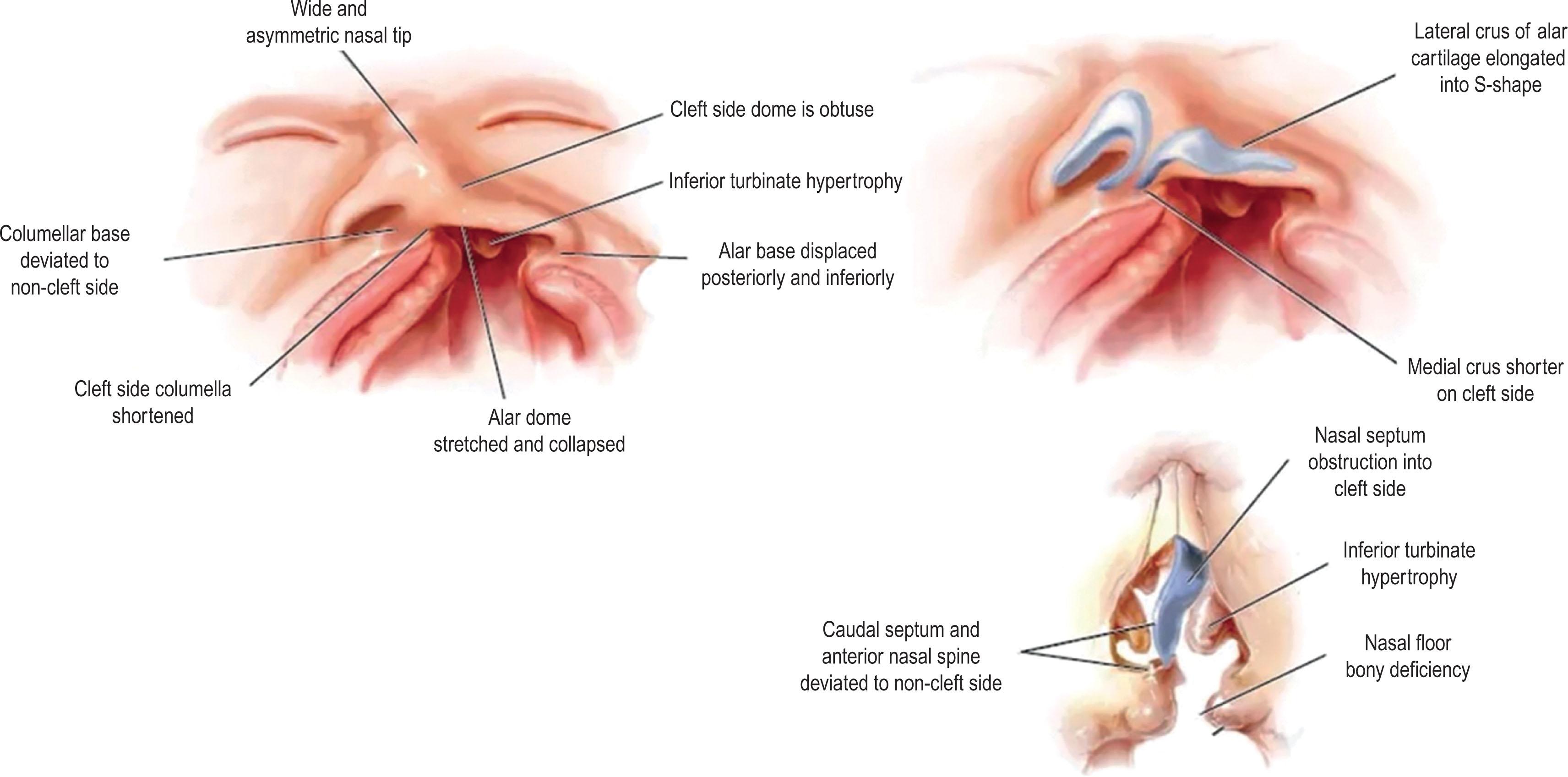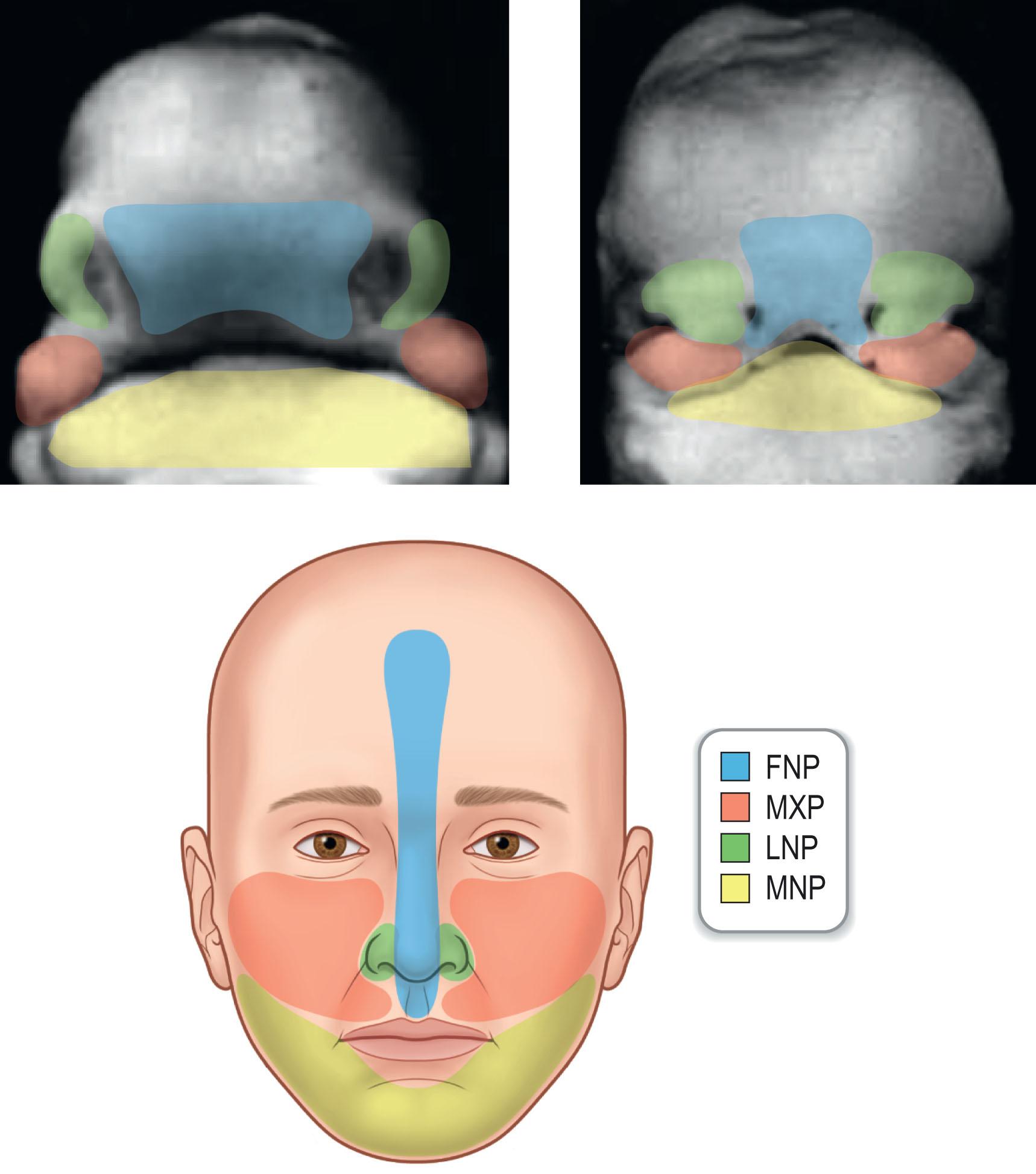Physical Address
304 North Cardinal St.
Dorchester Center, MA 02124
Access video lecture content for this chapter online at Elsevier eBooks+ ![]()
The social, cultural, and religious significance of the cleft lip has been documented throughout ancient history. Notable Peruvian pottery specimens dating back 3000 years have been linked to religious ceremonies and burial sites. A story originating from the Chin Dynasty of China (circa CE 390) recounts one of the earliest cleft lip repairs. The patient, an 18-year-old man from a poor farming family, approached the governor’s surgeon to correct his cleft lip. The surgeon agreed but only after instituting his strict postoperative protocol instructing that the man “rest the affected part for 100 days” during which time he “ingest only thin gruel” and “cannot smile or talk.” The story recounts that afterwards he “ overcame his handicap and became Governor General of six Chinese provinces”.
Before the advent of anesthesia, surgical repairs were crude. Cleft skin margins were rapidly excised and hastily closed in skin-only fashion. In 1460, Heinrich von Pfolsprundt, realizing the value of orbicularis oris muscle continuity, treated the cleft as a composite tissue defect by passing sutures through all layers of the lip. In the early 1700s, rudimentary pre-surgical infant orthopedics were introduced by Hieronymus Fabricius, whereby bandages were fashioned to minimize cleft width and reduce tension over the cleft margins prior to surgical repair. Some of today’s tenets of cleft lip repair were shaped by these contributions made over 550 years ago.
After the advent of chloroform anesthesia in 1847 surgical techniques became more sophisticated; surgeries could be designed to take longer and involve more surgical dissection with less patient pain and movement. Contemporaneously, as knowledge of cleft lip and nose pathoanatomy grew, broader surgical principles were realized and refined. New techniques focused on the nasal deformity and release of associated aberrant muscular insertions. M. H. Collins of Dublin began to reconstruct the displaced alar base. Later, more intentional efforts were made for scar concealment. Random-pattern geometric flaps of the lip and vermilion, such as the triangular and quadrilateral flaps, increased lip length and restored symmetry of Cupid’s bow. This chapter serves as an introduction to the following chapters, each of which serve as their own cleft care milestones in history.
The natural beauty of the upper lip is defined by its balanced symmetry of key structures: vermillion, mucosa, red line, Cupid’s bow, white roll, and philtrum. Each is a distinct region, with unique form, color, and texture. The vermilion is the red part of the lip that is exposed and dry. It is composed of capillary-rich keratinized skin without minor salivary glands giving it a unique pigmentation and texture that cannot be easily reproduced. The mucosa is the pink lining of the oral cavity and has a wet, shiny appearance. The red line is the junction of the vermilion and mucosa, or the wet–dry junction. Cupid’s bow is defined by the horizontal double curve of the lip and has two peaks. The white roll is a thin convex prominence that follows Cupid’s bow. It is sparse with vellus hair, which produces a light reflex that highlights the outline of Cupid’s bow. The philtrum has a central depression flanked by paired philtral ridges. The philtral dimple is formed by the decussation of the orbicularis oris muscle and the insertion of its muscle fibers into overlying skin. The orbicularis oris muscle is the main intrinsic muscle that encircles the mouth consisting of two functional components – the superficial (pars superficialis) and the deep (pars marginalis) components. The pars superficialis functions with nearby facial muscles of expression primarily to retract the upper lip. The pars marginalis runs under the vermillion across from one modiolus to the other and acts as a sphincter.
The characteristic surface structures of the lip and nose are disrupted by the unilateral cleft lip and nose deformity. Soft tissues are abnormally tethered to either side of the cleft. On the medial side, the lip is short, the philtral ridge is flattened, and the vermilion progressively narrows with the cleft margin. On the lateral side, the vermilion border and red-line wet–dry junction start parallel to one another but abruptly converge nearing the cleft. Noordhoff’s point is found along the lateral lip where the vermillion height is greatest; the white roll is well formed but diminishes medially.
The key to understanding cleft pathoanatomy is knowing the abnormal attachments of the orbicularis oris muscle ( Fig. 19.1.1 ). Orbicularis oris muscle fibers are misdirected into the anterior nasal spine, anterior nasal septum, and medial crus footplates on the non-cleft side and, on the cleft side lateral-lip element, to the alar base. Its unopposed pull rotates the greater alveolar segment anteriorly and deviates the nasal septum and columella to the non-cleft side. On the cleft side or lateral lip element, the orbicularis oris inserts abnormally into the periosteum of the piriform aperture. The alar base is tethered to the retropositioned lesser segment. The opposing splaying forces of the muscle stretch the nasal base across the cleft causing the lateral crus to elongate, flatten, and collapse on itself.

Unilateral cleft lip is one of the most common congenital anomalies. While the details of facial development are dynamic and extremely complex, a general understanding is critical to the cleft surgeon. In the first week following fertilization of the ovum, the zygote divides repeatedly into a mulberry-like cell mass known as the “morula”. While the morula migrates through the fallopian tube and enters the uterus it continues to divide into a blastocyst, which is composed of an inner and outer layer. The outer layer is the trophoblast, which contributes to the placental structures. The inner layer is the embryoblast, which develops into the embryo. During the second week of development the blastocyst implants into the uterine endometrium.
In the third week of human development, the embryoblast divides into three layers through a process called “gastrulation”, which leads to the three primary germ layers: ectoderm, mesoderm, and endoderm. Due to its major role in development, some refer to the neural crest as the “fourth germ layer”. The neural crest is especially important in craniofacial development and gives rise to the much of the neural, odontogenic, and skeletogenic tissues of the craniofacial region.
The orofacial region can be identified in the 4th week post-conception. At this point, an area of the trilaminar germ disk (typically consisting of the ecto-, meso-, and endoderm) lacks mesoderm, forming a bilaminar oropharyngeal membrane. The cavity adjacent to the oropharyngeal membrane marks the stomodeum (the primitive mouth), around which five facial prominences swell during the 4th week of embryogenesis. The stomodeum is bordered rostrally by the median frontonasal prominence, laterally by the paired maxillary prominences, and caudally by the paired mandibular prominences ( Fig. 19.1.2 ).

During the 4th through 10th weeks post-conception, the basic morphology of the face is developed, which is formed due to fusion of the frontonasal prominence and the maxillary, lateral nasal, and mandibular prominences (see Fig. 19.1.2 ). The frontonasal prominence – as its name indicates – forms the forehead, midline of the nose, the central lip (philtrum), and the primary palate. On the inferior and lateral aspects of this prominence form the bilateral nasal placodes, which then submerge to form the nasal pits. Each nasal pit communicates posteriorly with the stomodeum.
The medial nasal process of both sides gives rise to the middle portion of the nose, the middle portion of the upper lip, and anterior portion of the maxilla, as well as the primary palate. The maxillary processes grow medially and approach the lateral and medial nasal processes. As a result, the maxillary process pushes the medial nasal process towards the midline, where it then merges with its anatomic counterpart from the opposite side (see Fig. 19.1.2 ). The merging of the two medial nasal processes results in the formation of that part of the maxilla which carries the incisor teeth, and the primary palate and the central upper lip. The upper lip is therefore formed from the fusion of the maxillary process of each side and the medial nasal process. Thus, clefting of the lip is a result of failed fusion of the maxillary process and medial nasal process. The lateral nasal prominences give rise to the alae of the nose (see Fig. 19.1.2 ). The maxillary prominences give rise to the upper jaw and the sides of the face, the sides of the upper lip, and the secondary palate.
Clefts of the lip and the anterior maxilla are a result of defective development of the embryonic primary palate. Often when such clefts occur, the distortion of the facial development prevents the palatine shelves from making contact when they swing into the horizontal position. Thus, clefts of the primary palate are often accompanied by clefts of the secondary palate, both hard and soft.
Become a Clinical Tree membership for Full access and enjoy Unlimited articles
If you are a member. Log in here